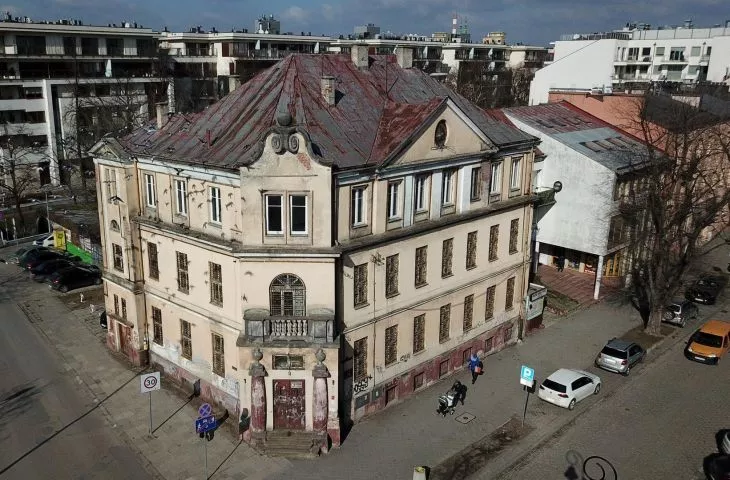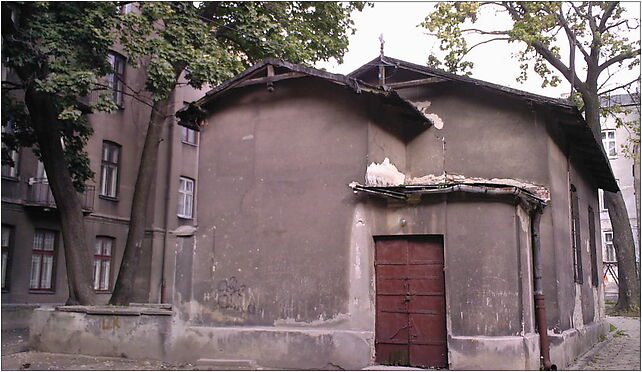Historic townhouses that have been deteriorating for years are a problem for many cities. And it doesn't matter whether private or municipal monuments, architecture is the heritage of our culture. What can be done to protect it? Every city strives to be attractive to residents and inviting to tourists, yet the lack of funds for the restoration of historic buildings is something absolutely standard. How does this happen? A perfect example is the story that is taking place in Kielce.
Popówka in Kielce - to be demolished | mat.press. Eska radio
According to an expert opinion, the walls, especially those in the basement, are in a terrible condition. This is the price of the fact that for years the owner did not take care of the building. It was unheated, which hastened its technical death. Moisture and frost did their job," says Anna Zak, Świętokrzyskie provincial conservationist.
A 19th-century tenement on the corner of Wesola and Mickiewicza streets in Kielce. Only the walls on the street side will remain from the original, and the rest will be rebuilt. Popovka was built according to a design by prominent Kielce architect Franciszek Ksawery Kowalski. The building is the last memory of the Orthodox church, which was located in today's Stefan Zeromski Square. In recent years the tenement stood empty. Eventually, it was taken over from the Military Property Agency by the prosecutor's office to arrange a new space for investigators there.
Popówka in Kielce - visualization | Inwestycje Kielce
The work is being carried out in consultation with the conservator of monuments. As for the facades from the side of the streets, they are to retain their original style. Here we will not change anything," assures prosecutor's office spokesman Daniel Prokopowicz.
Nothing? The contractor plans to add two floors, but.... with respect to the old architecture. Of course, interfering with historic buildings can still be aesthetically pleasing, but is it a necessity to bring them to a state suitable only for demolition, only to rebuild later "in the original style"?
"preserve the atmosphere of the tenements"
There are many more such historic buildings, excluded from use and falling into disrepair over the years, in Kielce alone. Two more tenements, at 3 Slowackiego St. and 4 Sniadeckich St., were built more than a century ago, at the beginning of the 20th century, at the request of the Zagajski family, very wealthy Kielce Jews, owners of, among other things, lime kilns in Wietrznia. Four years ago, the Dorbud company planned to adapt them into "beautiful apartments that will preserve the atmosphere of the tenements." Preparing the investment, among other things, the house of prayer standing in the courtyard was moved.
Zagajewski's historic house of prayer before it was removed from the square, Kielce | Targeo.pl
Dorbud, however, ran into trouble. - In March, the company went bankrupt, and all of its assets, including these townhouses, were taken over by a receiver. And before that, Dorbud had another trustee for two years," says Tomasz Tworek in an interview with Gazeta Wyborcza, president of Dorbud in bankruptcy. He adds that he even tries not to drive there, "so as not to look," writes Gazeta Wyborcza.
Protecting the urban layout is not enough
Why is it that in the end only the facades of historic buildings are saved, when the rest are eaten away by moisture and frost? Kielce's historic townhouses are protected as part of the urban layout. It is the facade that is inscribed as an element, but the foundations are no longer necessarily.... As conservator Anna Zak explains, the office is not able to regularly control all elements of the urban layout. There are already too many individual buildings anyway.
- There are so many of them that in practice we can inspect one building once every ten years," Anna explains.
Who watches over the condition of historic buildings? There is also a building supervisor, but this one primarily inspects safety, or more precisely, whether a deteriorating tenement does not endanger passersby.
- We can't order renovation as such. Decisions on aesthetics, when we found that something was crumbling, were overturned by the courts. Therefore, the attitude of the owner is crucial. Besides, the position of the conservator is needed anyway," explains Robert Wojnowski, district building inspector.
Demolition of a historic tenement in Kielce | naszekielce.pl
Dorbud also owns two other tenements from the 1930s. More than a decade ago, the owner argued that they were in a terrible condition, and the previous provincial conservator of historical buildings, Janusz Cedro, agreed to their demolition.
At 6 and 4 Piotrkowska Street stand two deteriorating tenement houses from the 19th century. They have been standing empty for years. In 2011, the then owner announced that a shopping arcade would be built there, and both tenements, were to be an elegant showcase. Although an outbuilding and outbuildings were demolished, the work stopped. In 2020, the bailiff put the plots up for sale....
- Very often one gets the impression that it is to the owners of such buildings that they collapse. Then it's easier to carry out the investment," comments Rafał Zamojski, downtown manager and lover of Kielce's history, in an interview with Gazeta Wyborcza.
"entry in the register of monuments does not save the building".
So what can save historic buildings if not conservation care? The owners' awareness of their obligation to take care of their property is independent of any regulations; it can only be strengthened by increased inspections. And for these you need the support of the city.


















